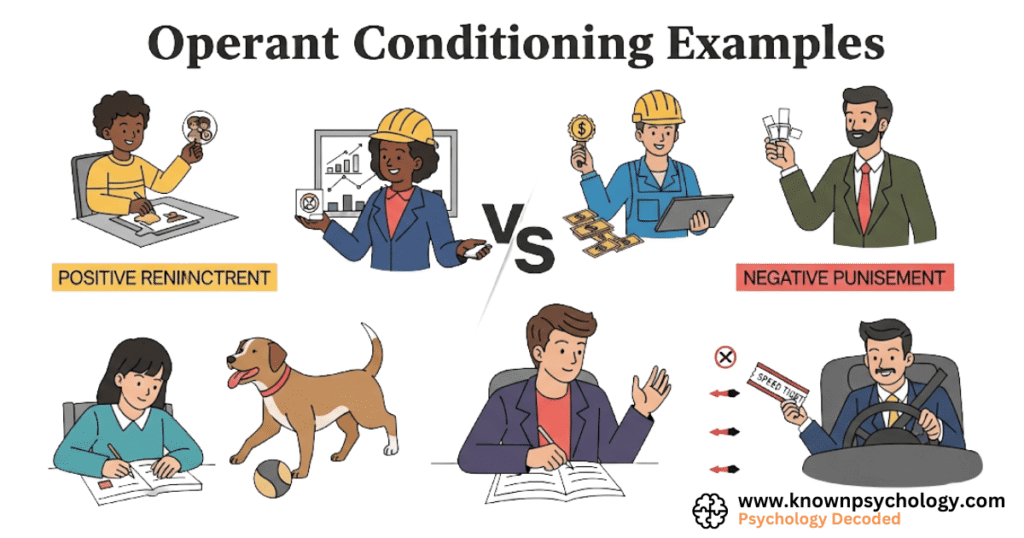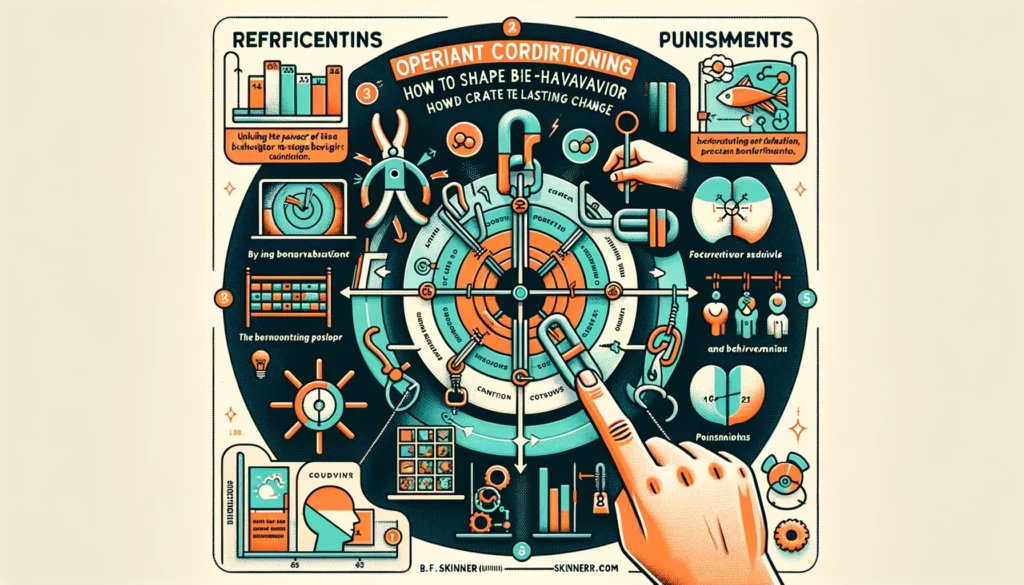Operant conditioning is a powerful concept in behavioral psychology, developed by B.F. Skinner. It explains how behavior is shaped by rewards and punishments. You may not realize it, but we experience operant conditioning examples in everyday life—from parenting and school to workplaces and even digital habits.
In this article, we’ll explore simple, relatable operant conditioning examples, how they work, and how they apply to your daily routine.

Key Takeaways
- Operant conditioning involves reinforcement and punishment to shape behavior.
- Common settings include homes, schools, workplaces, and apps.
- Operant conditioning examples in real life are everywhere—from parenting to productivity tools.
What Is Operant Conditioning?
Operant conditioning is a method of learning where behavior is controlled by consequences. The core elements include:
- Positive reinforcement (rewarding a behavior to encourage it)
- Negative reinforcement (removing something unpleasant to encourage behavior)
- Positive punishment (adding an unpleasant outcome to stop behavior)
- Negative punishment (taking away something pleasant to stop behavior)
These concepts come alive when we look at operant conditioning examples in real life.
Operant Conditioning Examples in Everyday Life at Home
1. Chore Charts for Kids
Parents use sticker charts or pocket money to reward children for doing chores.
👉 Positive reinforcement is used to encourage good habits.
2. Timeouts for Bad Behavior
Sending a child to timeout after they hit their sibling is a form of positive punishment—introducing an unpleasant situation to reduce the behavior.
3. Turning Off Wi-Fi for Not Doing Homework
This is negative punishment—taking away something enjoyable to reduce a behavior.
These are some of the most common operant conditioning examples in everyday life used by parents and guardians.
Operant Conditioning in Schools
1. Praise from Teachers
Students who answer correctly may receive verbal praise or class points. This positive reinforcement increases participation.
2. Detentions
A student receiving detention for breaking a rule is an example of positive punishment.
3. Extra Recess Time for Good Behavior
This is another form of positive reinforcement widely used in classrooms.
Such scenarios show clear operant conditioning examples in real life, especially in educational settings.
Operant Conditioning in the Workplace
1. Employee Bonus Systems
Offering bonuses for meeting targets reinforces productivity through positive reinforcement.
2. Warnings or Write-Ups
When employees receive warnings for poor performance, it acts as positive punishment.
3. Taking Away Perks
Removing access to flexible hours after repeated lateness is negative punishment.
These workplace practices are excellent operant conditioning examples used in performance management.
Real-Life Digital Examples of Operant Conditioning
1. Social Media Notifications
Platforms give dopamine-boosting notifications (likes, comments) to reward engagement. This is positive reinforcement.
2. Blocking Distracting Apps
If someone installs a productivity app that blocks social media when they’re distracted, it’s negative punishment.
3. Earning Badges in Mobile Games
These gamified rewards are powerful operant conditioning examples in real life that boost app usage.
Operant Conditioning in Pet Training
1. Treats for Following Commands
Giving a dog a treat after sitting on command is a classic positive reinforcement method.
2. Ignoring Unwanted Behavior
Sometimes trainers remove attention to discourage certain behaviors, which is negative punishment.
Conclusion
Understanding operant conditioning examples in everyday life helps us become more aware of how behaviors are shaped—whether we’re parenting, managing teams, or improving our own habits. It’s a foundational part of psychology that you see in real life constantly, often without realizing it.
Next time you give your dog a treat, praise your child, or take a break after finishing work—you’re likely using operant conditioning.
FAQs
1. What is the main idea of operant conditioning?
It’s a learning method where behaviors are shaped by consequences—either rewards or punishments.
2. Can operant conditioning be used on adults?
Yes. Bonuses, praise, consequences, and digital rewards are all examples of operant conditioning used with adults.
3. What’s the difference between reinforcement and punishment?
Reinforcement increases behavior; punishment decreases it.
4. What is the difference between classical and operant conditioning?
The main difference is that classical conditioning involves learning through association, while operant conditioning involves learning through consequences (rewards or punishments).
Mariam holds an MS in Sociology with a specialization in Medical Sociology and Social Psychology. With a strong academic background and extensive research work in both fields, she brings depth and clarity to complex topics. Her writing explores the intersection of society, health, and the human mind, making academic ideas easy to grasp and relevant to everyday life.


